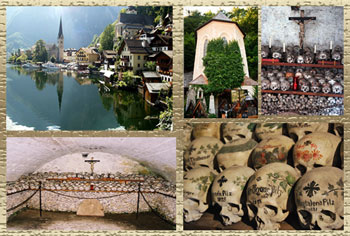Page 1 Page 2 Page 3 Page 4 Page 5

Because it was built into the hillside, she had worried that it would be a catacombs-type tunnel with flickering wall sconces. The actual room was small, probably not much larger than a mausoleum, and well lit. Instead of shelves with coffins, slanted racks — similar to those in a supermarket used to show off cabbages and other produce — displayed the skulls. She halfway expected sprigs of parsley to be tucked in beside them. There were no small ones — remainders of lost children. What happened to them? Hers had met the fate of all medical waste. She placed a red, flaky hand over her middle.
The lower jawbones were mostly missing. She assumed these came unhinged and were stored with larger bones stacked like kindling and firewood below the skulls. For several minutes, she checked out eye sockets and nose cavities, read names and inscriptions — noted these details as she might examine craft items at a county fair.
When Alex asked, “Are you ready to leave?” Megan felt no inclination. “You go ahead. I’ll be out soon.”
A crucifix hung above the racks. Once alone, she felt no urge to pray either. The odorless room was clean and seemingly free of dust. Maybe the guardian lady spent time with a collecting cloth, polishing pates when she wasn’t tidying the yard. Did many other curious people visit here? Most of the bones were ancient. Perhaps only a few people in Hallstatt still cared.
One recent addition, a woman’s skull, had a gold tooth lodged in the upper portion of what used to be her mouth. She was the last one to be included at the shrine. In the ’60s, with the acceptance of cremation by the Catholic Church, bodies were transported to Salzburg for the process. Sometime in the ’80s, apparently not looking forward to this prospect, the woman was granted a place in the Charnel House.
Did the guardian lady ever question what happened to the souls once encased in these skulls? Would she make a special request to be placed here as compensation for her devotion and labors? Did she live with a guilt so strong that, in guarding the Charnel House, she did her penance?
Megan touched the top of her own fine blond hair, moved the hand to her forehead (remembering years’ worth of smudged ashes), rubbed fingers in sockets that held her blue eyes, slid them over cheekbones, bumped across a mole, and came to rest at her pointed chin. The hard bones beneath her warm skin felt cushioned. She placed the hand on a pulse at her neck.
Megan had been protected from witnessing dead bodies. Her father kept her from looking in the casket at her mother’s remains. A vacuum-like device had rapidly sucked the fetus from her womb. Textbook illustrations showed them to have disproportionately huge heads and eyes.
She reached out and placed a finger on the woman’s skull. It was cold and hard and smooth as ivory, like a carved box her mother had used to store meaningful writings. Sometimes Megan read them, trying to feel closer. She took the yellow Post-it from her pocket. This one was by Byron as he contemplated a skull: “Look on its broken arch, its ruin’d wall/Its chambers desolate, and portals foul/Yet this was once Ambition’s airy hall/The dome of Thought, the palace of the Soul.”
***
Her soul still resided within. She was still alive. Not perfect, but with all the possibilities for change and growth. At that moment, something closed inside Megan as something else opened.
* * *
When she left the Charnel House, the guardian lady sat hunched over her desktop, maybe concentrating on accounts, seemingly oblivious to why people visited there.
Alex waited for Megan, standing patiently near the church’s stone wall.
Bells began to chime for five o’clock. “Should we take the easy way down?” she said.
“Steps are fine with me.”
“Your poor feet.”
“Plenty of time to rest them on our flight home.”
Her breathing slowed, her shoulders softened as they descended the stairway hand in hand. Surprisingly, hers felt less inflamed. His was still strong and clasping.
Quoted lines are from George Gordon, Lord Byron: “Childe Harold’s Pilgrimage,” II.vi.


Kathy, I wor